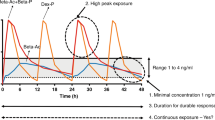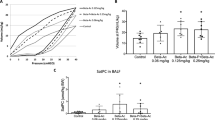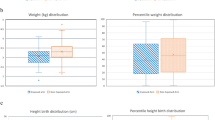Abstract
Objective
To examine the effect of antenatal corticosteroid administration (ACS) on fetal thymus growth in women who received ACS compared with gestational-age-matched controls.
Study design
Fetal thymus size and growth were measured in women at risk for preterm delivery who received ACS and compared with a matched cohort of women who were at low risk for preterm delivery and did not receive ACS. Fetal thymus perimeter and diameter were measured by 2-D ultrasound at baseline and every 2 weeks until delivery.
Results
After adjusting for confounders, ACS exposure was associated with a significant reduction in thymus perimeter size (−0.70; 95% CI: −1.33, −0.07; P = 0.03). For every additional week of exposure, thymus growth trajectory was significantly decreased in ACS-exposed fetuses (P = 0.04).
Conclusion
The association between ACS and reduced fetal thymus growth should be further examined to establish the impact of ACS on childhood thymus development and immune programming.
This is a preview of subscription content, access via your institution
Access options
Subscribe to this journal
Receive 12 print issues and online access
$259.00 per year
only $21.58 per issue
Buy this article
- Purchase on Springer Link
- Instant access to full article PDF
Prices may be subject to local taxes which are calculated during checkout

Similar content being viewed by others
References
Committee on Obstetric Practice. Committee opinion no. 713: antenatal corticosteroid therapy for fetal maturation. Obstet Cynecol. 2017;2:e102–9.
Roberts D, Dalziel S. Antenatal corticosteroids for accelerating fetal lung maturation for women at risk of preterm birth. Cochrane Database Syst Rev. 2006;19:CD004454.
Melamed N, Shah J, Soraisham A, Yoon EW, Lee SK, Shah PS, et al. Association between antenatal corticosteroid administration-to-birth interval and outcomes of preterm neonates. Obstet Gynecol. 2015;125:1377–84.
Gyamfi-Bannerman C, Thom EA, Blackwell SC, Tita AT, Reddy UM, Saade GR, et al. Antenatal betamethasone for women at risk for late preterm delivery. N Engl J Med. 2016;374:1311–20.
Andrews M, Matthews S. Antenatal glucocorticoids: is there cause for concern? Fetal Matern Med Rev. 2003;14:329–54.
Erni K, Shaqiri-Emini L, La Marca R, Zimmermann R, Ehlert U. Psychobiological effects of prenatal glucocorticoid exposure in 10-year-old-children. Front Psychiatry. 2012;3:104.
Aghajafari Murphy FK, Matthews S, Ohlsson A, Amankwah K, Hannah M. Repeated doses of antenatal corticosteroids in animals: a systematic review. Am J Obstet Gynecol. 2002;186:843–9.
Braun T, Challis JR, Newnham JP, Sloboda DM. Early-life glucocorticoid exposure: the hypothalamic-pituitary-adrenal axis, placental function, and long-term disease risk. Endocr Rev. 2013;34:885–916.
Chabra S, Cottrill C, Rayens MK, Cross R, Lipke D, Bruce M. Lymphocyte subsets in cord blood of preterm infants: effect of antenatal steroids. Biol Neonate. 1998;74:200–7.
Kavelaars A, van der Pompe G, Bakker JM, van Hasselt PM, Cats B, Visser GH, et al. Altered immune function in human newborns after prenatal administration of betamethasone: enhanced natural killer cell activity and decreased T cell proliferation in cord blood. Pediatr Res. 1999;45:306–12.
Cohen JJ, Duke RC. Glucocorticoid activation of a calcium dependent endonuclease in thymocyte nuclei leads to cell death. J Immunol. 1984;132:38–42.
Diemert A, Hartwig I, Pagenkemper M, Mehnert R, Hansen G, Tolosa E, et al. Fetal thymus size in human pregnancies reveals inverse association with regulatory T cell frequencies in cord blood. J Reprod Immunol. 2016;113:76–82.
Cho JY, Min JY, Lee YH, McCrindle B, Hornberger LK, Yoo SJ. Diameter of the normal fetal thymus on ultrasound. Ultrasound Obstet Gynecol. 2007;29:634–8.
Zalel Y, Gamzu R, Mashiach S, Achiron R. The development of the fetal thymus: an in utero sonographic evaluation. Prenat Diagn. 2002;22:114–7.
Streiner DL, Norman GR. Correction for multiple testing: is there a resolution? Chest. 2011;140:16–8.
Li L, Bahtiyar MO, Buhimschi CS, Zou L, Zhou QC, Copel JA. Assessment of the fetal thymus by two- and three-dimensional ultrasound during normal human gestation and in fetuses with congenital heart defects. Ultrasound Obstet Gynecol. 2011;37:404–9.
Peelen MJ, Kazemier BM, Ravelli AC, De Groot CJ, Van Der Post JA, Mol BW, et al. Impact of fetal gender on the risk of preterm birth, a national cohort study. Acta Obstet Gynecol Scand. 2016;95:1034–41.
Hertz-Picciotto I, Park HY, Dostal M, Kocan A, Trnovec T, Sram R. Prenatal exposures to persistent and non-persistent organic compounds and effects on immune system development. Basic Clin Pharm Toxicol. 2008;102:146–54.
Morrissey PJ, Charrier K, Alpert A, Bressler L. In vivo administration of IL-1 induces thymic hypoplasia and increased levels of serum corticosterone. J Immunol. 1988;141:1456–63.
Vacchio MS, Ashwell JD, King LB. A positive role for thymus-derived steroids in formation of the T-cell repertoire. Ann N Y Acad Sci. 1998;840:317–27.
Alexander N, Rosenlocher F, Stalder T, Linke J, Distler W, Morgner J, et al. Impact of antenatal synthetic glucocorticoid exposure on endocrine stress reactivity in term-born children. J Clin Endocrinol Metab. 2012;97:3538–44.
Iqbal M, Audette MC, Petropoulos S, Gibb SW, Matthews SG. Placental drug transporters and their role in fetal protection. Placenta. 2012;33:137–42.
Bale TL. Lifetime stress experience: transgenerational epigenetics and germ cell programming. Dialogues Clin Neurosci. 2014;16:297–305.
Dalziel SR, Walker NK, Parag V, Mantell C, Rea HH, Rodgers A, et al. Cardiovascular risk factors after antenatal exposure to betamethasone: 30-year follow-up of a randomised controlled trial. Lancet. 2005;365:1856–62.
Schaffer L, Luzi F, Burkhardt T, Rauh M, Beinder E. Antenatal betamethasone administration alters stress physiology in healthy neonates. Obstet Gynecol. 2009;113:1082–8.
Diepenbruck I, Much CC, Krumbholz A, Kolster M, Thieme R, Thieme D, et al. Effect of prenatal steroid treatment on the developing immune system. J Mol Med. 2013;91:1293–302.
Kuypers E, Collins JJ, Jellema RK, Wolfs TG, Kemp MW, Nitsos I, et al. Ovine fetal thymus response to lipopolysaccharide-induced chorioamnionitis and antenatal corticosteroids. PLoS One. 2012;7:e38257.
Kunzmann S, Glogger K, Been JV, Kallapur SG, Nitsos I, Moss TJ, et al. Thymic changes after chorioamnionitis induced by intraamniotic lipopolysaccharide in fetal sheep. Am J Obstet Gynecol. 2010;202:476 e471–9.
Yinon Y, Zalel Y, Weisz B, Mazaki-Tovi S, Sivan E, Schiff E, et al. Fetal thymus size as a predictor of chorioamnionitis in women with preterm premature rupture of membranes. Ultrasound Obstet Gynecol. 2007;29:639–43.
Olearo E, Oberto M, Ogge G, Botta G, Pace C, Gaglioti P, et al. Thymic volume in healthy, small for gestational age and growth restricted fetuses. Prenat Diagn. 2012;32:662–7.
Cromi A, Ghezzi F, Raffaelli R, Bergamini V, Siesto G, Bolis P. Ultrasonographic measurement of thymus size in IUGR fetuses: a marker of the fetal immunoendocrine response to malnutrition. Ultrasound Obstet Gynecol. 2009;33:421–6.
Mohamed N, Eviston DP, Quinton AE, Benzie RJ, Kirby AC, Peek MJ, et al. Smaller fetal thymuses in pre-eclampsia: a prospective cross-sectional study. Ultrasound Obstet Gynecol. 2011;37:410–5.
El-Haieg DO, Zidan AA, El-Nemr MM. The relationship between sonographic fetal thymus size and the components of the systemic fetal inflammatory response syndrome in women with preterm prelabour rupture of membranes. BJOG. 2008;115:836–41.
Basu S, Dewangan S, Shukla RC, Anupurva S, Kumar A. Thymic involution as a predictor of early-onset neonatal sepsis. Paediatr Int Child Health. 2012;32:147–51.
Aksakal SE, Kandemir O, Altinbas S, Esin S, Muftuoglu KH. Fetal thymus size as a predictor of histological chorioamnionitis in preterm premature rupture of membranes. J Matern Fetal Neonatal Med. 2014;27:1118–22.
Jeppesen DL, Ersboll AK, Nielsen SD, Hoppe TU, Valerius NH. Low thymic size in preterm infants in the neonatal intensive care unit, a possible marker of infection? A prospective study from birth to 1 year of age. Acta Paediatr. 2011;100:1319–25.
Kolte L, Rosenfeldt V, Vang L, Jeppesen D, Karlsson I, Ryder LP, et al. Reduced thymic size but no evidence of impaired thymic function in uninfected children born to human immunodeficiency virus-infected mothers. Pediatr Infect Dis J. 2011;30:325–30.
Garly ML, Trautner SL, Marx C, Danebod K, Nielsen J, Ravn H, et al. Thymus size at 6 months of age and subsequent child mortality. J Pediatr. 2008;153:683–8. 688 e1–3
Moore SE, Fulford AJ, Wagatsuma Y, Persson LA, Arifeen SE, Prentice AM. Thymus development and infant and child mortality in rural Bangladesh. Int J Epidemiol. 2014;43:216–23.
Airo P, Scarsi M, Brucato A, Benicchi T, Malacarne F, Cavazzana I, et al. Characterization of T-cell population in children with prolonged fetal exposure to dexamethasone for anti-Ro/SS-A antibodies associated congenital heart block. Lupus. 2006;15:553–61.
Namazy JA, Chambers C, Schatz M. Safety of therapeutic options for treating asthma in pregnancy. Expert Opin Drug Saf. 2014;13:1613–21.
Magu S, Gathwala G, Agarwal S, Parihar A. Sonographic measurement of thymic size in preterm infants: prediction model for thymic size in the Indian subcontinent. Indian J Pediatr. 2012;79:764–8.
Gamez F, De Leon-Luis J, Pintado P, Perez R, Robinson JN, Antolin E, et al. Fetal thymus size in uncomplicated twin and singleton pregnancies. Ultrasound Obstet Gynecol. 2010;36:302–7.
De Leon-Luis J, Gamez F, Pintado P, Antolin E, Perez R, Ortiz-Quintana L, et al. Sonographic measurements of the thymus in male and female fetuses. J Ultrasound Med. 2009;28:43–8.
Gur EB, Gur MS, Ince O, Kasap E, Genc M, Tatar S, et al. Vitamin D deficiency in pregnancy may affect fetal thymus development. Ginekol Pol. 2016;87:378–83.
Michie CA, Hasson N, Tulloh R. The neonatal thymus and antenatal steroids. Arch Dis Child Fetal Neonatal Ed. 1998;79:F159.
C. Society for Maternal-Fetal Medicine Publications. Implementation of the use of antenatal corticosteroids in the late preterm birth period in women at risk for preterm delivery. Am J Obstet Gynecol. 2016;215:B13–5.
Acknowledgements
The authors would like to acknowledge Sharon Adams (SA), Meredith Hood (MH), Caroline Crerar (CC), and Louisa Loizides (LL), sonographers employed at St. Michaels Hospital, for performing the ultrasounds for this study. The authors would also like to thank Kate Besel, research assistant at St. Michaels Hospital, and David Gurau, resident in Obstetrics and Gynaecology at the University of Toronto, for helping with study recruitment and recording study data.
Author information
Authors and Affiliations
Corresponding author
Ethics declarations
Conflict of interest
The authors declare that they have no conflict of interest.
Additional information
Publisher’s note Springer Nature remains neutral with regard to jurisdictional claims in published maps and institutional affiliations.
Supplementary information
Rights and permissions
About this article
Cite this article
Jones, C.A., Nisenbaum, R., De Souza, L.R. et al. Antenatal corticosteroid administration is associated with decreased growth of the fetal thymus: a prospective cohort study. J Perinatol 40, 30–38 (2020). https://doi.org/10.1038/s41372-019-0554-z
Received:
Revised:
Accepted:
Published:
Issue Date:
DOI: https://doi.org/10.1038/s41372-019-0554-z
This article is cited by
-
Thymic Atrophy and Immune Dysregulation in Infants with Complex Congenital Heart Disease
Journal of Clinical Immunology (2024)
-
Evaluation of fetal thymus size in maternal autoimmune diseases: systemic lupus erythematosus, Sjögren’s syndrome and antiphospholipid antibody syndrome
Archives of Gynecology and Obstetrics (2023)



